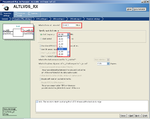shaiko
Advanced Member level 5
Hello,
Clock A is an input to an Altera Aria V FPGA.
I want to use a PLL to generate 2 internal clocks out of clock A:
1. Clock B - which is clock A shifted by 90 degrees.
2. Clock C - which is X2 of clock A (without a phase shift).
Plot thickens...clock A is also the timing signal of a serial data stream.
10 serial bits for every clock A cycle.
I want it to be the synchronization signal of a SERDES and parallelize the incoming stream.
Is it possible to use clock A for the generation of clocks B & C while at the same time it will sync a SERDES ?
Clock A is an input to an Altera Aria V FPGA.
I want to use a PLL to generate 2 internal clocks out of clock A:
1. Clock B - which is clock A shifted by 90 degrees.
2. Clock C - which is X2 of clock A (without a phase shift).
Plot thickens...clock A is also the timing signal of a serial data stream.
10 serial bits for every clock A cycle.
I want it to be the synchronization signal of a SERDES and parallelize the incoming stream.
Is it possible to use clock A for the generation of clocks B & C while at the same time it will sync a SERDES ?
